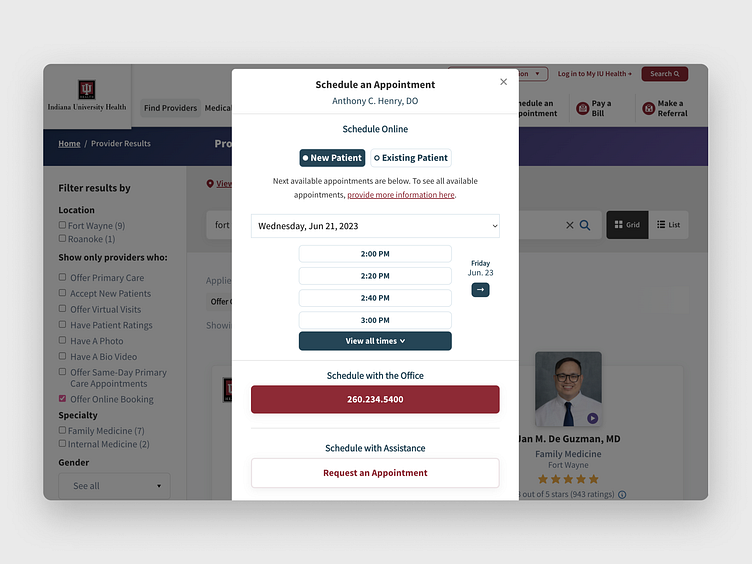IU Health Online Scheduling Interface
This project was completed in 2021 for Indiana University Health
My Role - Product Designer
Tools Used: Sketch, Adobe Photoshop
Overview
Indiana University Health (IU Health) is a leading healthcare provider with a network of over 5,000 dedicated health professionals. We understand the importance of providing our patients with convenient and seamless appointment booking options, whether they are new or existing patients. To meet their needs, our team has been actively gathering feedback through site surveys and user testing, which has guided us in implementing an online booking system for our providers. We have partnered with an external vendor to integrate this system with our database, ensuring a smooth and efficient scheduling experience for our valued patients.
The Problem
The default user flow for this product initially directs users to a form where they are required to provide pre-appointment information. However, this process involves multiple fields and pages before users can access the available appointment dates and times.
Project Goal
On the Find Providers search page, we will design an interface that prominently displays the available appointment dates and times for the chosen providers. This intuitive interface will allow users to easily select their preferred appointment slot. Once a selection is made, users will be seamlessly directed to the appointment form to proceed with scheduling. This streamlined process aims to enhance user convenience and efficiency when booking appointments with their desired providers.
Design Process
Original Design
The original mockup was created by our development team to give a representation of our capabilities for the interface and to assist with the design phase of this project.
Creating the designs
Upon receiving the reference from our developers, my role entailed refining the design to align with the existing styling of our site while ensuring a clear and intuitive experience for our users. Drawing inspiration from the provided reference, I worked diligently to harmonize the design elements, incorporating visual consistency and cohesiveness throughout the interface. The objective was to create a seamless and visually appealing user experience that seamlessly integrates with our site's overall aesthetic.
Research
To ensure consistency with our user base's expectations, I conducted thorough research on multiple competitors, analyzing their UI patterns and design approaches. This comprehensive investigation enabled me to identify common trends and best practices within our industry. By aligning our UI patterns with what our users are accustomed to, we aim to provide a familiar and intuitive experience that instills confidence and ease of use.
Final Design
After collaborating closely with our development team to establish a connection with the third-party vendor API, the final design underwent some modifications. These adjustments were made to seamlessly integrate the functionality provided by the vendor into our interface. Through this collaborative effort, we ensured that the design not only met our visual and user experience goals but also effectively harnessed the capabilities of the third-party vendor. The result is a final design that combines our original vision with the necessary technical integrations, culminating in a cohesive and robust solution.
Design Changes
Incorporated informational text to inform users that the displayed list of appointment times is not exhaustive and there are more options available.
Transitioned to a single column layout for the list of times, allowing seamless integration of the "View all Times" functionality.
Enhanced user experience by transforming "View all Times" into a prominent button, improving visibility and making it more accessible for users.
Outcome
I take great pride in the outcome we have achieved, as it provides our users with various avenues to schedule their care and significantly enhances their overall experience.
This update has been particularly beneficial for users with hearing disabilities, enabling them to independently schedule their appointments. Reading the positive feedback from these users about how this enhancement has increased their independence warms my heart and reinforces the impact of user-focused design on people's lives. It serves as a reminder of the profound influence our work can have on others and the importance of prioritizing user needs and inclusivity in our design efforts.




